Media
Visit Ithaca has your media needs covered, including providing quick and accurate information, story ideas, images and video, and filling interview requests. We also welcome media visits and are happy to assist in itinerary development and coordinating connections to our partners.
Be sure to follow our social media feeds on Instagram, Facebook and Twitter to see more of our destination’s highlights!

Rob Montana Communications Manager
Favorite hidden gem: Cascadilla Creek Gorge Trail. This beautiful natural area is tucked right into the heart of downtown Ithaca, and it surprises you with its waterfalls along the ¾-mile walk. It’s closed during the winter, but once the snow melts, it offers a nice way to go from downtown to Cornell University.
More about Ithaca
Ithaca, which takes its name from the Greek island of Ithaca in Homer’s Odyssey, is located in the Finger Lakes Region of central New York State. It is four hours from New York City, three hours from Niagara Falls, two hours from Rochester and four hours from Philadelphia.
The Finger Lakes Region is comprised of 14 counties, which occupy 9,000 square miles, roughly comparable in size to the states of Vermont, New Hampshire or New Jersey.
Ithaca sits at the southern tip of Cayuga Lake, the longest of the 11 Finger Lakes. Cayuga Lake is named after the Cayuga Indian Nation, one of the six nations of the Iroquois Confederacy.
The City of Ithaca is home to both Cornell University (established in 1865) and Ithaca College (established in 1892), and Tompkins County is home to Tompkins Cortland Community College (established in 1968).
There are four state parks within 10 miles of downtown Ithaca. They are Buttermilk Falls State Park, Robert Treman State Park, Allen Treman State Marine Park and Taughannock Falls State Park.
Ithaca is famous for its many waterfalls, more than 100 within 10 miles of downtown. If you put them all together, it's a waterfall 7,342 feet tall. That's 1.39 miles of falling water!
January is the coldest month, with average high temperatures of 31 degrees Fahrenheit and average low temperatures of 15 degrees Fahrenheit. July is the warmest month of the year, with average high temperatures of 80 degrees and average low temperatures of 58 degrees Fahrenheit.
The average annual precipitation is 37.3 inches and the average annual snowfall is 65 inches.
City of Ithaca
Year Incorporated: 1888
Population: 32,108 (2020 Census estimate)
Median age: 22.1
Median household income: $38,019
Area: 5.39 square miles
Tompkins County
Year Incorporated: 1817
Population: 105,740 (2020 Census estimate)
Median age: 31.3
Median household income: $61,361
Area: 474.64 square miles
Ithaca Fun Facts
Famous Ithacans include actor Asia Kate Dillon (Orange is the New Black/Billions), Alex Haley (author, “Roots”), Ricky Jay (magician/actor), Carl Sagan (astronomer), Rod Serling (television writer, “The Twilight Zone”), David Foster Wallace (writer) and Paul Wolfowitz (former World Bank president).
Famous Cornell University alumni include Gary Bettman (NHL commissioner), Kyle Dake (Olympic gold medalist), Ruth Bader Ginsburg (former Supreme Court justice), Mae Jemison (astronaut), Bill Nye (the Science Guy), Bill Maher (comedian and television host), Rob Manfred (MLB commissioner), Christopher Reeve (actor), Janet Reno (former U.S. Attorney General), Thomas Pynchon (writer) and E.B. White (writer, “Charlotte’s Web”).
Famous Ithaca College alumni include David Boreanaz (actor, Buffy the Vampire Slayer/Angel/Bones), Gavin DeGraw (musical artist, though he did not graduate), Ben Feldman (Emmy nominated actor, Mad Men/ Superstore), Bob Iger (former CEO of The Walt Disney Company), and David Muir (journalist, ABC World News Tonight anchor).
The city's modern history began in the late 18th Century when Congress awarded Revolutionary War soldiers land grants (in lieu of combat pay) to settle the area. Local deeds are still based on the original "Military Tract," designated in 1790.
An intrepid boater can cast off from Ithaca and cruise the storied Erie Canal system all the way to NYC and the Atlantic Ocean. Westbound, the canal leads boaters into the Great Lakes, the Mississippi and ultimately to the Gulf of Mexico.
The Moosewood Restaurant, famous for its award-winning vegetarian cookbooks, has been an Ithaca landmark since 1973.
Ithaca was a film capital from 1913-1920 with numerous silent films produced at Wharton Studios in Stewart Park.
Wizard of Oz author L. Frank Baum was a likely visitor to Ithaca while his future wife attended Cornell University. At the time, yellow bricks paved local roads.
Dr. Robert A. Moog, founder of Moog Music and the inventor of the legendary Moog synthesizer received his Ph.D. from Cornell in engineering physics in 1965 and was a longtime resident of Trumansburg, N.Y. Cornell University now houses his archives.
Ithaca had its own currency, "Ithaca Hours." This alternative legal tender was widely used in town and has been featured in more than 400 media outlets nationally and abroad.
The Ithaca Gun Company, whose namesake smokestack remains a local landmark, was established in 1880 and produced some of the world's finest shotguns. Among its patrons were John Philip Sousa and Annie Oakley.
Famous Ithaca Discoveries & Creations
First Ice Cream Sundae: The first Ice Cream Sundae was invented by a local fountain owner Chester Platt and Unitarian reverend John Scott on April 3, 1892.
First French-bread Pizza: The first French-bread pizza was created at Cornell University by Bob Petrillose as a cheaper pizza option for college students, well before Stouffer's made their frozen version!
First Electric Streetlamps: America's first electric streetlamps lit the Cornell campus in the winter of 1875-1876.
"Puff the Magic Dragon" Origin: The song "Puff the Magic Dragon" was penned in Ithaca. Cornell student Lenny Lipton wrote it as a poem and passed it on to Peter Yarrow, who later turned it into a song in the Peter, Paul and Mary classic.
Famous Novel "Lolita": Novelist Vladimir Nabokov wrote "Lolita" in Ithaca, and he almost burned it here after the story was rejected by every American publisher. His wife changed literary history when she pulled the manuscript from the incinerator behind their rented house on East Seneca Street.



